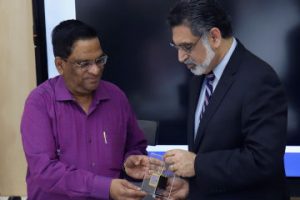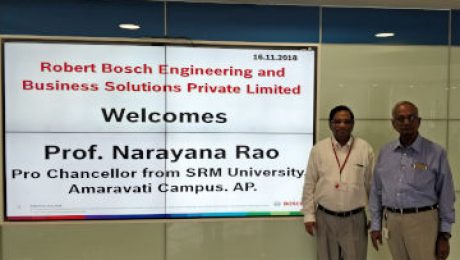SRM AP Pro Vice Chancellor Dr. D. Narayana Rao and BOSCH to establish Bosch-SRM Research Centre for Artificial Intelligence in health care
The Robert Bosch Engineering and Business Solutions Pv.t Ltd in Bangalore along with SRM AP will set up a centre at SRM Amaravati to carry out research in Artificial Intelligence for health care. SRM AP Pro Vice Chancellor Dr. D. Narayana Rao and BOSCH Bangalore have been in discussions on this initiative that will bring together researchers from SRM AP’s engineering program and Bosch, a leading supplier of technology and services in mobility solutions, industrial technology and energy.
- Published in News, Research News
SRM AP’s new cell culture facility to pioneer bio-medical research

Dr. Anil K. Suresh, Principal Investigator, Associate Professor, Biological Sciences with SRM AP Pro VC Prof. Narayana Rao
A newly established research facility in the main academic block will house advanced equipment for research related to applications like cellular culture, drug delivery, cell imagingand cell cytotoxicity. Dr. Anil K. Suresh, Principal Investigator of the cell culture laboratory who is currently an Associate Professor at the department of Biological Sciences spearheaded the acquisition of lab equipment such as the Type 2 biosafety cabinet, CO2 incubators, cell counting machine, inverted and upright microscopes, table-top centrifuge, – 20 and 4 degree refrigerators and cell storage facility.
- Published in News, Research News
University of Texas at Arlington and SRM AP propose research collaboration and student exchange programs.

SRM AP Pro VC Prof. Narayana Rao presenting memento to UTI President, Vistasp Karbhari
December 03, 2018: In a joint discussion presided by SRM AP Pro VC Prof. Narayana Rao, Registrar D. Gunasekaran, SRM AP faculty and staff, Pranesh Aswath, UTI Vice Provost for Academic Planning and Policy, UTI President Karbhari spoke of how, in face of global changes in education and workforce demands, education must adapt in modality with a flexible and adaptive curriculum. Karbhari explained the strides UTI has made in these critical areas.
- Published in News, Research News
SRM AP at MIT Design Camp – MITx, OCW and local content: Powerful new tools for enhanced teaching/learning
SRM AP’s engineering curriculum (through an exclusive agreement with MITx to access latest material on the edX edge platform) builds on basic MITx courses that include Computer Science and Programing; Mathematics, Calculus, Introduction to Classical Mechanics, Circuits and Electronics and Computation Structures. To ensure the effective delivery of these courses (that include lecture videos and notes, practice problems, and exam materials) MIT conducts annual design camps through its office of digital learning.
- Published in News


